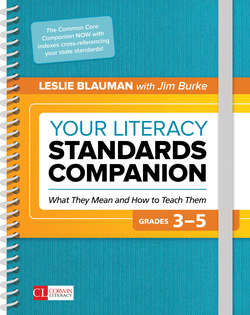Читать книгу Your Literacy Standards Companion, Grades 3-5 - Leslie Blauman - Страница 25
На сайте Литреса книга снята с продажи.
Common Core Reading Standard 1: Academic Vocabulary: Key Words and Phrases
ОглавлениеCite specific textual evidence: Students should be able to quote a specific passage from the text to support all claims, assertions, or arguments about what a text means or says. Evidence comes from within the text itself, not from the reader’s opinion or experience.
Demonstrate understanding of a text: Readers take a group of details (different findings, series of events, related examples) and draw from them an insight or understanding about their meaning or importance within the passage of the text as a whole.
Drawing inferences: To understand the text by generalizing, deducing, and concluding from reasoning and evidence that is not presented literally or explicitly. These conclusions are based on textual clues.
Explicitly: Clearly stated in great or precise detail; may pertain to factual information or literal meaning, though this is not necessarily always the case.
Informational text: These include nonfiction texts from a range of sources and written for a variety of purposes; everything from essays to advertisements, historical documents to op-ed pieces. Informational texts include written arguments as well as infographics.
Key details: Parts of a text that support the main idea, and enable the reader to draw conclusions and infer what the text or a portion of a text is about.
Literature: Fiction, poetry, drama, graphic stories, but also artworks by distinguished painters, sculptors, or photographers.
Logical inferences (drawn from the text): To infer, readers add what they learned from the text to what they already know about the subject; however, for an inference to be “logical,” it must be based on evidence from the text.
Quote accurately: “Lifting lines” directly from the text or copying specific sections of the text to demonstrate understanding. All claims, assertions, or arguments about what a text means or says require specific examples from the text.
Read closely (aka close reading): Reading that emphasizes not only surface details but the deeper meanings and larger connotations between words, sentences, and the full text; also demands scrutiny of craft, including arguments and style used by the author.
Text: In its broadest meaning, a text is whatever one is trying to read: a poem, essay, drama, story, or article; in its most modern sense, a text can also be an image, an artwork, speech, or multimedia format such as a website, film, or social media message such as a tweet.
Textual evidence: Not all evidence is created equal; students need to choose those pieces of evidence (words, phrases, passages illustrations) that provide the best proof of what they are asserting about the text.
